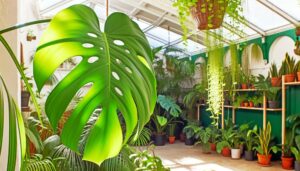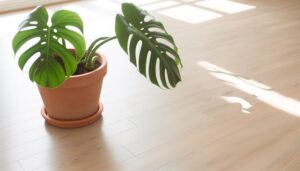Does Monstera Plant Need Sunlight? Essential Tips!
Monstera plants thrive in bright, indirect sunlight, replicating their natural rainforest habitat. Position yours near an east-facing window to provide ideal light without causing leaf burn.
Direct sunlight can lead to photodamage, breaking down chlorophyll and scorching the leaves. While they tolerate low light, growth may slow, and fewer leaf splits will appear.
Make sure light exposure is balanced; use a light meter to maintain 200-400 foot-candles. For insufficient natural light, incorporate full-spectrum LED grow lights.
Learn how to optimize their indoor conditions and monitor for light stress to keep your Monstera healthy and vibrant.
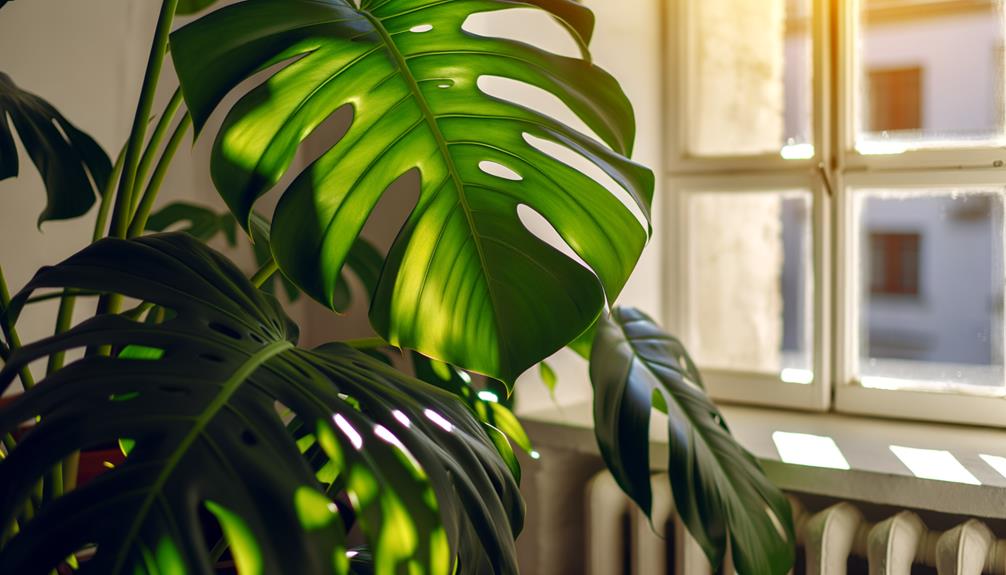
Key Takeaways
- Monstera thrives in bright, indirect sunlight for optimal growth.
- It can tolerate low light but will grow slower and with less fenestration.
- Direct sunlight can cause leaf burn and chlorophyll breakdown.
- Monstera benefits from 200-400 foot-candles of light for photosynthesis.
- Artificial full-spectrum LED lights can supplement insufficient natural light.
Natural Habitat of Monstera
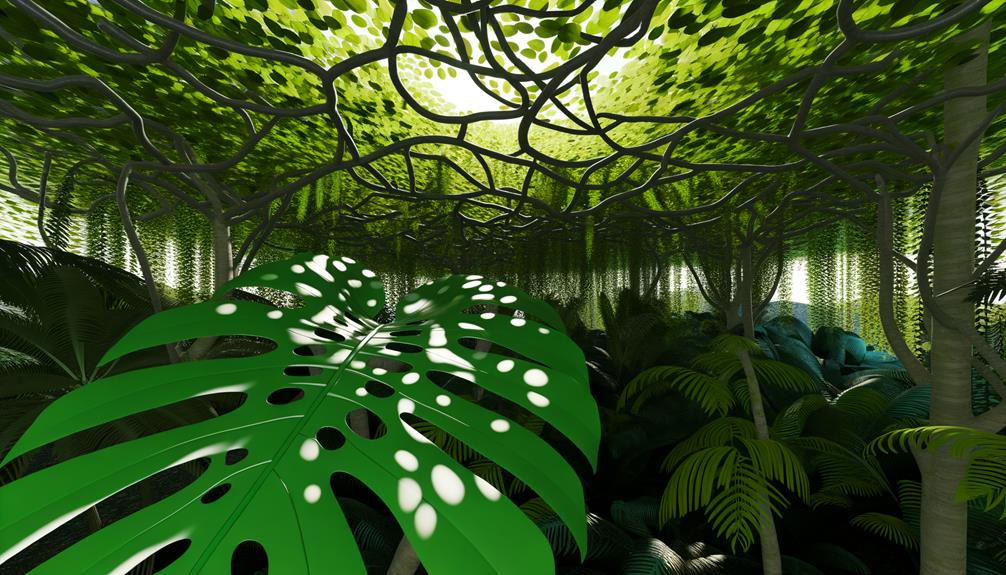
Originating from the tropical rainforests of Central and South America, Monstera plants thrive in environments with indirect sunlight and high humidity. In their natural habitat, they’re understory plants, meaning they grow beneath the forest canopy. This positioning allows them to receive dappled light filtered through the dense foliage above.
The high humidity, typically around 70-90%, supports their epiphytic nature where they attach to trees and absorb moisture from the air. You’ll find that they exhibit aerial roots, which are adaptations to climb and stabilize themselves. Additionally, the rich, well-draining soil of the rainforests contributes to their best growth.
Understanding these specific environmental conditions is essential for replicating them in a domestic setting to maintain the health and energy of your Monstera plant.
Light Preferences
You should position your Monstera in an area with bright, indirect sunlight for best growth. Research indicates that indirect light benefits the plant by mimicking its natural habitat while preventing leaf burn.
Although Monsteras can tolerate low light conditions, their growth rate and leaf development may be greatly hindered.
Optimal Light Conditions
Monstera plants thrive best in bright, indirect sunlight, which mimics the dappled light of their natural rainforest habitat. You should aim for light conditions that allow the plant’s photosynthetic processes to function efficiently without causing photoinhibition.
Excessive direct sunlight can lead to chlorophyll degradation, while insufficient light can stunt growth and reduce leaf fenestration.
Here’s a breakdown of ideal light conditions:
| Light Condition | Description | Impact on Monstera |
|---|---|---|
| Bright Indirect Light | Filtered sunlight | Ideal growth |
| Low Light | Dim, no direct sunlight | Slow growth, smaller leaves |
| Direct Sunlight | Unfiltered, direct sun | Leaf burn, chlorosis |
| Full Shade | No direct or indirect light | Dormancy, yellow leaves |
| Medium Light | Some filtered sunlight | Moderate growth |
Ensure your Monstera receives consistent, appropriate light for best results.
Indirect Sunlight Benefits
Understanding the benefits of indirect sunlight for Monstera plants can optimize their growth and overall health, guaranteeing that they flourish under conditions that closely resemble their natural environment.
Indirect sunlight offers a balanced light intensity that minimizes the risk of photodamage, such as leaf scorching. Research indicates that Monstera plants thrive in bright, filtered light, which promotes photosynthesis without overwhelming their cellular structures.
In your indoor setting, positioning the Monstera near an east-facing window or using sheer curtains can replicate these ideal conditions. Additionally, indirect light aids in maintaining the plant’s humidity levels, essential for its aerial roots.
Adhering to these guidelines will guarantee your Monstera develops large, fenestrated leaves, a hallmark of a healthy specimen.
Low Light Tolerance
While Monstera plants show some tolerance for low light conditions, their growth rate and leaf fenestration greatly benefit from brighter, indirect light environments. In low light, you’ll notice slower growth and fewer splits in the leaves.
A study published in the Journal of Plant Physiology found that Monstera plants exposed to indirect sunlight displayed enhanced photosynthetic efficiency and increased biomass accumulation. Providing about 200-400 foot-candles of indirect light can enhance their physiological functions.
Although they can survive in low light, prolonged periods in such conditions may lead to etiolation, characterized by elongated stems and reduced leaf size. For the best growth, place your Monstera in an area where it receives bright, indirect light, avoiding direct sun to prevent leaf scorch.
Direct Sunlight Impact
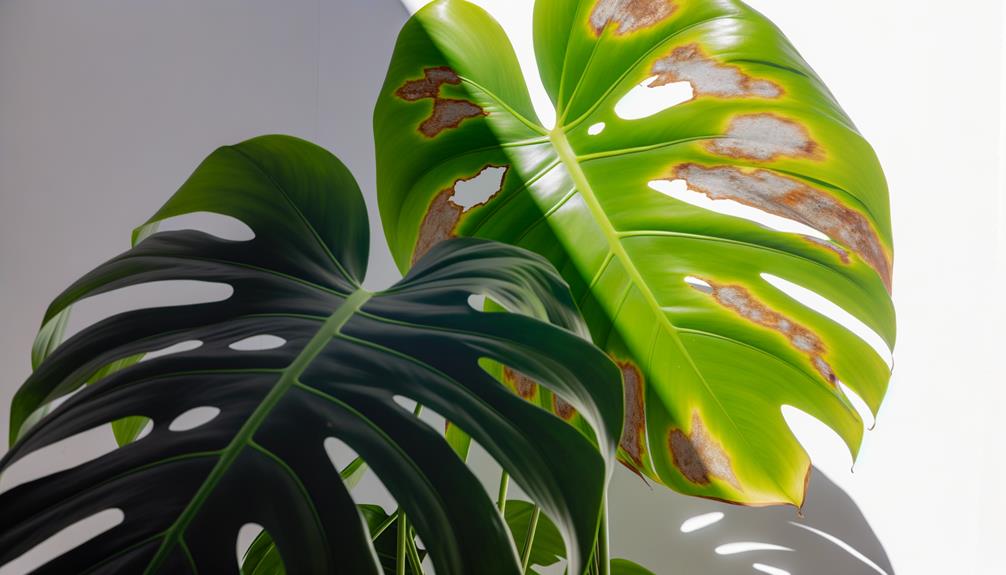
Exposing Monstera plants to direct sunlight can lead to leaf burn and reduced overall health, as evidenced by numerous horticultural studies.
When you place a Monstera in direct sunlight, the intense light can break down chlorophyll, resulting in chlorosis—yellowing of leaves. Additionally, photodamage occurs, leading to necrotic spots and leaf desiccation.
Direct sunlight elevates transpiration rates, causing the plant to lose water rapidly, which can induce stress and hinder growth. Photosynthetic efficiency declines under these conditions due to the excessive light intensity overwhelming the plant’s photo-protective mechanisms.
For best health, you should monitor the plant’s exposure carefully, ensuring it receives diffused light to prevent these adverse effects and maintain its physiological functions.
Ideal Indoor Lighting
For best growth, Monstera plants thrive most under bright, indirect light conditions, which mimic their natural understory rainforest habitat. Place your Monstera near an east or north-facing window to enhance light exposure without direct sun, which can cause leaf burn. Employing sheer curtains can scatter intense sunlight, creating an ideal environment.
Research indicates that Monstera plants benefit from a light intensity of approximately 10,000 to 20,000 lux. Utilize a light meter to monitor these levels, ensuring they remain within the prime range. Artificial grow lights can supplement natural light, especially in low-light areas, maintaining photosynthesis and overall plant health.
Regularly rotate the plant to guarantee even light distribution and prevent asymmetrical growth.
Signs of Light Stress
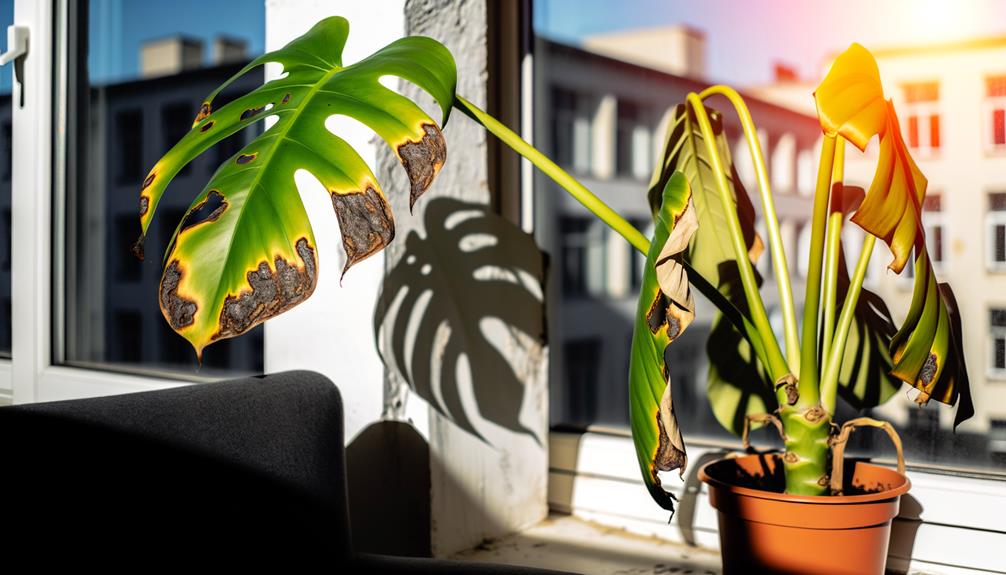
Monitoring your Monstera for signs of light stress is crucial for promoting plant health and preventing irreversible damage. Look for specific indicators that your plant is experiencing photoinhibition or photodamage.
- Leaf Discoloration: Yellowing or browning of leaves often indicates excessive light exposure.
- Scorched Leaves: Brown, crispy edges suggest sunburn, usually from direct sunlight.
- Leggy Growth: Stems elongate more than normal, a sign of insufficient light, known as etiolation.
These symptoms are evidence-based markers of light stress. Adjusting the light conditions promptly can mitigate these issues.
Use a light meter to measure intensity and optimize it within the ideal range for Monstera. Regularly inspecting your plant’s foliage and growth patterns will help you maintain its health effectively.
Seasonal Light Changes
You need to adjust your Monstera’s light exposure based on seasonal variations to guarantee ideal growth.
During winter, the plant benefits from increased light exposure due to reduced daylight hours.
Conversely, in summer, providing shade is essential to protect against excessive light and potential leaf burn.
Winter Light Requirements
As winter approaches, understanding how reduced daylight hours affect your Monstera plant’s growth and overall health is crucial. Lower light availability can profoundly impact photosynthesis, leading to stunted growth.
To mitigate this, you should:
- Adjust Placement: Move your Monstera closer to windows that receive the most sunlight, ideally south or west-facing.
- Supplement with Artificial Light: Utilize grow lights to maintain adequate light levels, ensuring they emit the full spectrum of light.
- Monitor Watering: Reduced light means less water is needed. Overwatering can lead to root rot, so check soil moisture regularly.
Spring Sunlight Adaptation
Spring’s increasing daylight hours require an adjustment in your Monstera plant’s exposure to sunlight to enhance its growth and health. As daylight expands, the plant’s photosynthetic activity intensifies, needing more light for efficient chlorophyll production.
Place your Monstera in an area where it receives indirect, filtered light to prevent photoinhibition, which can harm the leaves. Scientific studies demonstrate that Monstera deliciosa thrives with approximately 100-500 foot-candles of light. Gradually acclimate the plant to higher light levels to avoid stress.
Monitor leaf color and growth rate; vibrant, green leaves indicate ideal light conditions. Analyzing these clues helps promote the plant’s successful adaptation to spring’s changing light, thereby fostering strong development and sustained energy.
Summer Shade Needs
During the intense summer months, protecting your Monstera from direct sunlight is crucial to prevent leaf scorch and encourage ideal growth. Excessive sunlight can trigger photodamage, resulting in chlorophyll breakdown and leaf necrosis. Position your Monstera in a location with filtered light or partial shade.
To optimize conditions, consider the following:
- Shade Cloth: Use a 40-60% shade cloth to scatter sunlight.
- Indoor Placement: Position the plant near east or north-facing windows where light is less harsh.
- Natural Shading: Utilize larger plants or trees to offer natural shade outdoors.
Implementing these strategies minimizes the risk of photoinhibition and guarantees that your Monstera maintains strong, healthy foliage throughout the summer.
Supplementing Natural Light
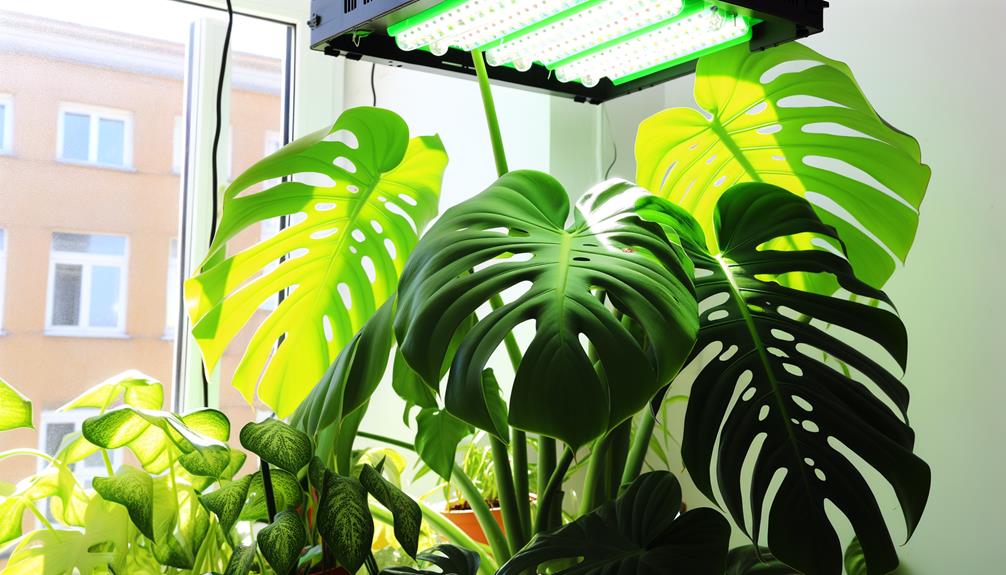
When natural light is insufficient for your Monstera plant, incorporating grow lights can effectively meet its photosynthetic needs.
Utilize full-spectrum LED grow lights, which mimic sunlight and provide the necessary wavelengths for photosynthesis.
Position the lights about 12-18 inches above the plant to optimize light penetration without causing leaf burn.
Studies indicate that Monstera plants thrive under 12-14 hours of artificial light per day, guaranteeing balanced growth.
Monitor the light intensity using a light meter, aiming for 2000-2500 lux.
Adjust the duration and distance based on the plant’s response to prevent etiolation or photoinhibition.
Implementing these strategies guarantees your Monstera receives adequate light, promoting healthy foliage and robust growth even in low-light conditions.
Best Room Placement
To optimize your Monstera plant’s growth, place it in a room with bright, indirect sunlight, ideally near an east or south-facing window.
This placement guarantees the plant receives adequate light without exposure to direct sunlight, which can cause leaf burn. An east-facing window provides gentle morning light, while a south-facing window offers consistent illumination throughout the day.
Consider the following factors to determine the best room:
- Light Intensity: Ensure the room has ample brightness but avoid direct sunlight.
- Temperature Stability: Monstera thrives in stable temperatures between 65-75°F.
- Humidity Levels: Maintain humidity around 60%, as Monstera prefers a humid environment.
Common Lighting Mistakes
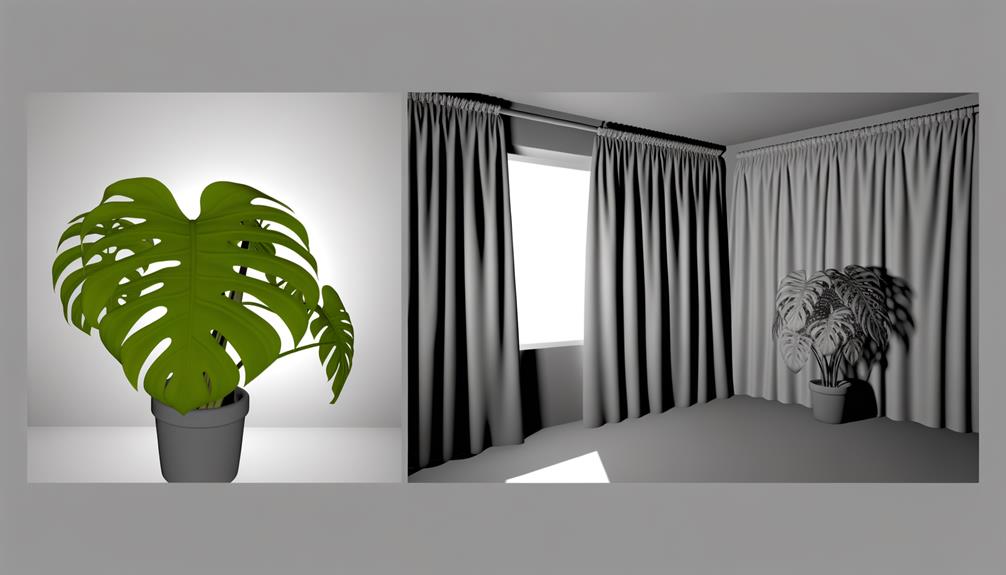
One common lighting mistake is placing your Monstera in direct sunlight, which can lead to leaf scorching and stunted growth. Direct sunlight causes photobleaching, where chlorophyll degrades, resulting in pale, damaged leaves. Aim for indirect, filtered light to promote optimal photosynthesis without causing stress.
Another error is underestimating the light needs; low light leads to etiolation, where your plant grows leggy and weak. Utilize a light meter to guarantee your Monstera receives 100-500 foot-candles for balanced growth.
Lastly, inconsistent lighting conditions can confuse your Monstera’s circadian rhythm, hindering its natural growth patterns. Rotate your plant every few weeks to maintain uniform light exposure and prevent uneven growth. Secure consistent, appropriate lighting for a healthy Monstera.
Conclusion
To sum up, understanding your Monstera’s light needs can make the difference between a thriving plant and a struggling one. Don’t underestimate the power of proper lighting—it’s the lifeblood of your plant’s growth.
By placing it in a bright, indirect light and avoiding direct sunlight, you’ll see flourishing leaves and robust health.
Remember, paying attention to light conditions isn’t just a recommendation; it’s the golden rule for Monstera care. Happy growing!


